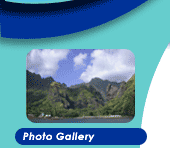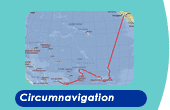











Sunday, March 25, 2007
Massawa, Eritea, Africa
Go
to photogallery
The Countries of the Red Sea
By Lois Joy
Get
out your atlas or globe, for this is a lesson in geography as well as sailing:
Pacific
Bliss has crossed The Red Sea from the Arabian Peninsula to sail along the
African coastline. Then we'll be sailing north along the Sudan coastline and
on to Egypt. I remember back when we were planning our circumnavigation. In
my naïveté, I said, "Oh the Red Sea. Those countries over
there are unsafe and always warring with each other. We'll just skip them
all and sail right up the center, stop to sightsee in Egypt, then on through
the Suez." That's before I found out how fearsome the Red Sea itself
can become. If one is lucky (as we have been so far) one can time it right
and sail partway way up in favorable winds (or motor in no wind, if one has
enough diesel). But if those fearsome winds come up from the wrong direction,
one needs a place to hide. The hiding places are called "marsas,"
small anchorages tucked behind the hazardous reefs that line both shores of
the Red Sea.
There
are some countries along the Red Sea that are more friendly to cruisers than
others, and some that should be absolutely avoided, e.g. Somalia. One doesn't
go within 60 miles of the Somalian coastline. Yemen is now on the coalition
side in the "war against terror," promises Coast Guard protection
to cruisers and welcomes tourists. So we could stop in Aden, then sail the
Yemeni coastline to the Strait of Bab el Mandeb, the chokepoint that is called
"The Gate of Sorrows," and up the Red Sea. The pilot books advise
against sailing along the Saudi Arabian coast, right north of Yemen, hence
the crossing to the other side, the Eritrean coast.
One
of our fleet had to make an emergency stop in Jeddah, Saudi Arabia. He was
caught in a storm, ripped a sail, and 3 of his four bilge pumps were not working.
"They don't want us there," he reported back on the NET. They wanted
him to take on an agent for $3000-$5000 US just to take on fuel. The captain
finally bought some from a local tugboat. Saudi Arabia is a closed country,
not set up for tourism.
This
leaves Eritrea and Sudan as cruising stops.
Eritea
has the second lowest GDP in the world, according to our version of the Red
Sea Pilot, yet it is a happy, friendly place where the first words the yachties
here is "Welcome to our country, welcome." It is an old land with
a new name. In ancient times it was part of the great Kingdom of
Aksum, a dominant 4th century power. It was the Italians of the 19th century
who called their new Red Sea Colony, Eritrea, a flight of nostalgia for the
classical Mediterranean world of Roman glory. Erythros means red in classical
Greek. When the Italians were defeated in 1941, the British took over until
1952. In that year, without the Eritreans being asked, their country was handed
over to Emperor Haile Selassie's Ethiopia, in accordance with UN resolution.
A big mistake. The idea was for a federal state within which Eritrea would
be automonous. It failed. In 1962 the Ethiopians declared a military state.
The Eritrean parliament voted itself out of existence and Eritrea became merely
a province. Almost immediately, the Eritrean People's Liberation Front (EPLF)
formed, the beginning of nearly three decades of war, drought and famine for
both Eritrea and Ethopia.
In
1974, Haile Selassie was deposed and Ethopia became a radical, leftist country,
aligned with the Soviet Union. The war continued against the Eritrean rebels.
In 1989, preliminary peace talks began. Finally, in 1993, a UN referendum
on self-determination led to an independent Eritrea. But it has not been quiet.
Since then, there have been disputes with Yemen over the Hanish Islands and
with Djibouti over their common border. Two more years of fighting with Ethiopia
began in 1998, ostensibly over a patch of barren desert. In July of 2000,
the UN brokered a peace agreement. In November of that year, peacekeeping
troops arrived to provide a buffer zone between the two countries. The countries
remain enemies. As a consequence of Eritrean independence, Ethiopia lost its
access to the Red Sea, probably the real cause of the most recent conflict.
The
country has about 5 million people who speak nine different languages. Tigrinya
is predominant in this sea port of Massawa. Arabic, Afar, English and Italian
are also common. The people are fiercely proud of their country and its new
flag, the most beautiful we've seen in the Middle East so far. It is green
over blue, with a red triangle based on the hoist bearing the symbol of the
Liberation Front,a yellow wreath of leaves around a six-branched tree.
|
|
 |
 |
 |
|
|||||||||
|
|
|
||||||||||||
|
|
|
||||||||||||
|
|
|
||||||||||||
|
|
|
|
|
|
|
|
|
|
|||||
|
|
|
||||||||||||
|
|
|
||||||||||||
 |
 |
|
|||||||||||
|
|
|
||||||||||||
|
|
|
||||||||||||
|
|
|
||||||||||||
 |
|
||||||||||||
|
|
|
||||||||||||
|
|
 |
|
|||||||||||
 |
|
||||||||||||
 |
|
||||||||||||
 |
|
||||||||||||
 |
|
||||||||||||
 |
|
||||||||||||
|
|
|
|
|
|
|
|
|
|
|
|
|
|
|